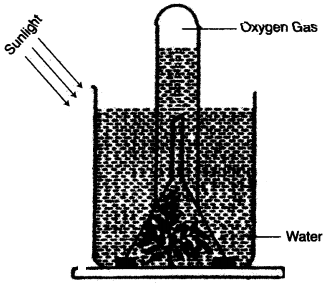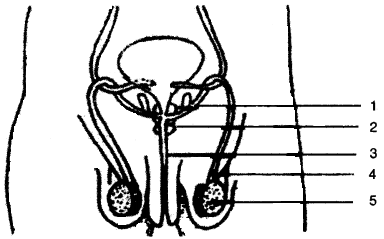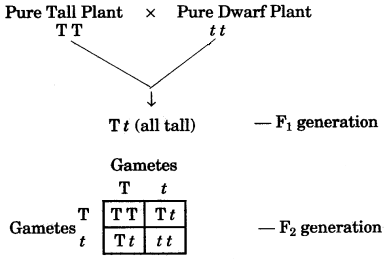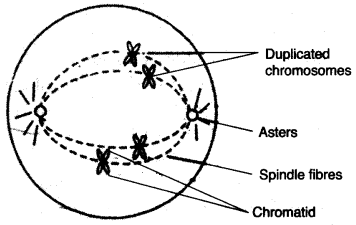ICSE Biology Previous Year Question Paper 2010 Solved for Class 10
ICSE Paper 2010 BIOLOGY
SECTION-I (40 Marks)
(Attempt all questions from this Section)
Question 1:
(a) Name the following :
(i) The type of cell division which occurs in the cells of the reproductive organs.
(ii) A plant with sunken stomata.
(iii) A foreign body that induces the formation of antibodies in the body.
(iv) The place where fertilization occurs in the female reproductive system.
(v) An organization that looks after maternal and child welfare centres. [5]
(b) State whether the following statements are true or false. If false, rewrite the correct form of the statement by changing the first or last word only.
(i) Tubectomy is the surgical method of sterilisation in males.
(ii) Mitosis is the type of cell division occurring in the cells of injured parts of the body.
(iii) Photolysis is the process of splitting of water molecules in the presence of grana and temperature.
(iv) Dilation of the pupil is brought about by the sympathetic nervous system.
(v) Chromosomes other than the pair of sex chromosome are called alleles. [5]
(c) Given below are five sets df five terms each. In each case, rewrite the terms in logical sequences as directed at the end of each statement, One has been done for you as an example.
Example : Anaphase, Telophase, Prophase, Metaphase, Interphase.
(sequential order of Karyokinesis)
Answer : Interphase, Prophase, Metaphase, Anaphase, Telophase.
(i) Vagina, Ovary, Uterus, Oviduct, Cervix (pathway of egg after ovulation)
(ii) Motor Neuron, Receptor, Sensory Neuron, Effector, Association Neuron.
(pathway of a nerve impulse)
(iii) Pupil, Yellow Spot, Cornea, Lens, Aqueous humour (path of entry of light into the eye from an object)
(iv) Stoma, Mesophyll cells, Xylem, Substomatal space, Intercellular space, (loss of water due to transpiration)
(v) Cortical cells, root hair, soil, water, endodermis, xylem. (entry of water into the plant from the soil) [5]
(d) There are five sets consisting of five terms given below. In each set there is a word which is an odd one. For each of these sets write down the category of the group having identified the odd one out, as shown in the example :
Example : (0) cell wall, vacuole, centrosome, plastids, mitochondria.
| S.No. | Category | Odd One |
| 1 | Organelles of Plant Cell | Centrosome |
(i) Blinking, Knitting without looking, Smiling, Blushing, Crying.
(ii) Myopia, Cataract, Hypermetropia, Squint, Cretinism.
(iii) Cowper’s gland, Urethral gland, Lachrymal gland, Seminal vesicles, Prostrate gland.
(iv) Vasopressin, Growth hormone, TSH, ACTH, FSH.
(v) Cresol, DDT, Lime, Mercurochrome, Bordeaux mixture. [5]
(e) Choose the correct answer to the following statements out of the three choices given after each statement.
(i) A point of contact between two neurons is termed:
(1) Synapsis (2) Neuro motor junction (3) Synapse
(ii) Loss of wateras droplets from hydathodes is called :
(1) Transpiration (2) Bleeding (3) Guttation
(iii) The technical term for the fertilized egg is:
(1) Placenta (2) Zygote (3) Morula
(iv) The photo receptor cells of the retina sensitive to colour are :
(1) Cones (2) Rods (3) Organ of Corti
(v) Salk’s vaccine is used to build immunity against:
(1) Tuberculosis (2) Poliomyelitis (3) Malaria [5]
(f) The figure below represents an experiment set up to study a physiological process in plants:
 (i) Name the physiological process being studied.
(i) Name the physiological process being studied.
(ii) Explain the process.
(iii) What is the aim of the experiment ?
(iv) Give a wall balanced equation to represent the process. [5]
(g) Given below is an example of a certain structure and its special functional activity:
Example : (0) Ribosomes and Protein synthesis. On a similar pattern complete the following:
(i) Hypothalamus and ……… .
(ii) Suspensory ligaments and ……… .
(iii) Semi circular canals and ……… .
(iv) Mitochondria and ……… .
(v) Seminiferous tubules and ……… . [5]
(h) Explain the following terms :
(i) Antibiotics
(ii) Antiseptic
(iii) Hormones
(iv) Diffusion
(v) Destarched plant. [5]
Answer:
(a) (i) Meiosis
(ii) Nerium
(iii) Antigen
(iv) Fallopian tube
(v) Red Cross
(b) (i) False; Vasectomy is the surgical method of sterilisation in males.
(ii) True.
(iii) False; Photolysis is the process of splitting of water molecules in the presence of grana and light.
(iv) True.
(v) False; Chromosomes other than the pair of sex chromosome are called autosomes.
(c) (i) Ovary, Oviduct, Uterus, Cervix, Vagina.
(ii) Receptor, Sensory Neuron, Association Neuron, Motor-Neuron, Effector.
(iii) Cornea, Aqueous humour, Pupil, Lens, Yellow spot.
(iv) Xylem, Mesophyll cells, Intercellular space, Substomatal space, Stoma.
(v) Soil, Water, Root hair, Cortical cells, Endodermis, Xylem.
(d)
| S. No. | Category | Odd One |
| (i) | Simple reflex | Knitting without looking |
| (ii) | Eye defects | Cretinism |
| (iii) | Male reproductive system | Lachrymal gland |
| (iv) | Anterior pituitary secreted | Vasopressin |
| (v) | Disinfectants | Mercurochrome |
(e) (i)—(3) Synapse
(ii)—(3) Guttation
(iii)—(2) Zygote
(iv)—(1) Cones
(v)—(2) Poliomyelitis.
(f) (i) The physiological process being studied is photosynthesis.
(ii) It is the process by which green plants manufacture glucose from carbon dioxide and water which they get from atmosphere and soil respectively.
(iii) The aim of the experiment is to find out that oxygen is given out during photosynthesis.
(iv)

(g) (i) Hypothalamus and control pituitary function.
(ii) Suspensory ligaments and to held lens in position.
(iii) Semi circular canals and balancing the body.
(iv) Mitochondria and release of energy.
(v) Seminiferous tubules and spermatogenesis.
(h) (i) Antibiotics: The chemical substances which are produced by a micro¬organism, can stop growth of or kill another micro-organism. e.g., Pencillin.
(ii) Antiseptics—These are chemical substances which destroy some bacteria and prevent the growth of others. Antiseptics are used locally in contact of body tissues because they are mild and are harmless to the tissues they work upon.
Examples of antiseptics—Tincture, benzoic acid, boric acid, hydrogen peroxide, dettol and mercurochrome.
(iii) Hormones: According to Selye (1948), “Hormones are the physiological organic compounds produced by certain cells for the sole purpose of directing theractivities to distant parts of the same origins.”
A hormone is defined as “a chemical messenger secreted by an endocrine gland which reaches its destination by the blood stream and which has the power of influencing the activity of other distant target organs.”
(iv) Diffusion: It is the process of movement of molecules of a substance (solid, liquid or gas) from the region of their higher concentration to the region of their lower concentration through the concentration gradient.
Or
Diffusion may be defined as the process of random movement of molecules of a substance from a region of higher concentration to a region of lower concentration.
(v) Destarched plant: The plant which has no starch in the leaves and the leaf remains yellowish brown when the leaf is tested for photosynthesis with iodine solution.
SECTION-II (40 Marks)
(Attempt any Four questions from this Section.)
Question 2:
(a) Given below is the outline of the male reproductive system :
 (i) Name the parts labelled 1 to 5.
(i) Name the parts labelled 1 to 5.
(ii) State the functions of the parts labelled 1 and 4.
(iii) Name the cells of part 5 that produce testosterone.
(iv) Why is the structure 5 present outside the body in the scrotal sacs ?
(v) What is semen ? [5]
(b) Given one point of difference between the following on the basis of what is given in the brackets :
(i) Myopia and Hypermetropia. (cause of the defect)
(ii) Cerebrum and Spinal cord. (arrangement ofcytons and axons of neuron)
(iii) Genotype and Phenotype. (definition)
(iv) Karyokinesis and Cytokinesis. (explain the term)
(v) Light reaction and Dark reaction. (site of occurrence) [5]
Answer:
(a) (i) 1—Seminal vesicle
2—Prostate gland
3— Urethra
4— Sperm duct/vas deferens
5—Testis.
(ii) Part 1—Its secretion serves as a medium for the transportation of the sperms.
Part 2—It carry the sperms.
(iii) Leydig cells or interstitial cells of part 5 produces testosterone.
(iv) The structure 5 is present outside the body in the scrotal sac because sperms are produced at 2 to 3°C lower than that of body temperature so, when too hot the skin of scrotal sac looses and testes are away from the body and when it is cold the skin contracts and testis are closer to the body for warmth.
(v) Semen—The mixture of seminal vesicles secretios and sperms produces a milky fluid, which is called semen.
(b) (i)
| Myopia | Hypermetropia |
| Lengthened of the eyeball from front to back. | Shortening of the eyeball from front to back. |
(ii)
| Cerebrum | Spinal cord |
| Axons (white matter) on the inner side and cytons (gray matter) on the outer side are present. | Cytous (Gray matter) on the inner side and Axons (white matter) on the outer side are present. |
(iii)
| Genotype | Phepotype |
| It is the genetic makeup of an organism. | It is the physical appearance of an organism. |
(iv)
| Karyokinesis | Cytokinesis |
| The division of nucleus during cell division are called karyokinesis. | The division of cytoplasm after karyokinesis is called cytokinesis. |
(v)
| Light Reaction | Dark Reaction |
| It takes place in the grana of chloroplast. | It takes place in the stroma of chloroplast. |
Question 3:
(a) (i) State Mendel’s Law of Dominance.
(ii) A pure tall plant (TT) is crossed with a pure dwarf plant (tt).
Draw Punnett squares to show (1) F1 generation (2) F2 generation.
(iii) Give the Phenotype of the F2 generation.
(iv) Give the Phenotypic and Genotypic ratio of the F1 and F2 generation.
(v) Name any one X-linked disease found in humans. [5]
(b) Answer the following briefly :
(i) Three functions of WHO.
(ii) Three advantages of a small family.
(iii) Explain the terms :
(1) Population density
(2) Natality. [5]
Answer:
(a) (i) Mendel’s Law of Dominance: Out of a pair of contrasting characters present together, only one is able to express itself while the other remain suppressed.
(ii)
 (iii) Phenotype of the F2 generation: Pure tall : Hybrid tall : Pure dwarf
(iii) Phenotype of the F2 generation: Pure tall : Hybrid tall : Pure dwarf
(iv) Genotypic ratio of F1 generation: Tt
Phenotype of F1 generation — All tall (Hybrid)
Phenotype ratio of F2 generation = 3 : 1
Genotypic ratio of F2 generation = 1 : 2 : 1
(v) X-linked disease found in human is – Haemophilia.
(b) (i) Three functions of WHO:
(a) To direct and co-ordinate international health projects.
(b) To encourage and conduct scientific research.
(c) To organise international campaigns, to control and eliminate diseases like AIDS.
(ii) Three advantages of a small family:
(a) Children get proper education,
(b) Children can get proper medical facilities.
(c) Children can get proper diet and nutrition.
(iii) (1) Population density: The sum total of individuals in a given geographic region at a specified period is known as the population density. It is the number of individuals in an unit area, such as per square kilometre.
(2) Natality: It is the number of live births per 1000 people of population per year.
Question 4:
(a) Given below is a diagram of a double helical structure of DNA :
 (i) Name the four nitrogenous base’s that form a DNA molecule.
(i) Name the four nitrogenous base’s that form a DNA molecule.
(ii) Give the full form of DNA.
(iii) Name the unit of heredity.
(iv) Mention two points of difference between Mitosis and Meiosis. [5]
(b) (i) Draw a well labelled diagram of a Neuron showing the following parts :
Perikaryon, Dendrites, Axon, Node of Ranvier and Myelin sheath.
(ii) State the function of sensory neuron and a motor neuron.
(iii) What is a nerve made up of ? [5]
Answer:
(a) (i) Adenine, Guanine, Cytocine, Thymine
(ii) De-oxy Ribosenucleic Acid.
(iii) Genes.
(iv)
| Mitosis | Meiosis |
| (1) Occurs in somatic cells. | (1) Occurs in reproductive cells. |
| (2) Produces two daughter cells. | (2) Produces four daughter cells |
(b) (i)

(ii) Sensory Neuron: It brings the impulse from the receptor to the brain or spinal cord.
Motor Neuron: It brings the impulse from the brain or spinal cord to all effector.
(iii) A nerve is made up of a bundle of nerve fibres or axons.
Question 5:
(a) Given below is the diagram of an apparatus set up to study a very important physiological process:
 (i) Name the process being studied.
(i) Name the process being studied.
(ii) Explain the process.
(iii) What change would you observe in the thistle funnel containing sugar solution after about 10 minutes ?
(iv) Is sugar solution hypertonic or hypotonic ?
(v) Name the part of the plant cell which is represented by the sugar solution.
(vi) Explain why much salt is added to pickles. [5]
(b) Explain the following terms :
(i) Reflex action
(ii) Vaccination
(iii) Turgidity
(iv) Bleeding in plants
(v) Cataract. [5]
Answer:
(a) (i) Osmosis.
(ii) The diffusion of water molecules through a semipermeable membrane from a dilute solution to concentrated solution.
(iii) After about 10 minutes the sugar solution in the thistle funnel rises up.
(iv) Hypotonic.
(v) Cell sap of the root hair.
(vi) The addition of much salt to pickle, the water molecule drawn out of the germ cell by plasmolysis. Thus pickle can be preserved for long duration.
(b) (i) Reflex Action: Reflex action is an automatic, quick and involuntary action in the body brought about by a stimulus. Reflexes are of two types :
(1) Simple (natural) reflexes and.
(2) Conditioned (acquired) reflexes.
(ii) Vaccination: Vaccination is the practice of artificially injecting mild form of the germs; Weakened (attenuated) germs, killed germs or the toxins produced by the germs into the body for the development of resistance to diseases.
(iii) Turgidity: The state in which the cell wall is fully stretched and cannot accommodate any more water.
(iv) Bleeding in plants: In plants direct flowing out of plant sap from any cut surface or from an injured part.
(v) Cataract: The eye condition in which the lens turns opaque and vision is cut down even to total blindness.
Question 6:
(a) Given below is an outline of the human body showing the important glands.
 (i) Name the glands marked 1 to 5.
(i) Name the glands marked 1 to 5.
(ii) Name the hormone secreted by 2. Give one important function of this hormone.
(iii) Name the endocrine cells present in part 3.
(iv) Name the hormone secreted by part 4.
Give one important function of this hormone. [5]
(b) Give the biological / technical term for the following :
(i) Cessation of menstruation in females.
(ii) An eye defect in which the cornea becomes uneven.
(iii) The period of complete intrauterine development of the embryo.
(iv) Inflammation of meninges.
(v) Non identical twins produced by the fertilization of two eggs.
(vi) Membrane that protects the foetus and secretes a protective fluid.
(vii) Process of conversion of several molecules of glucose to one molecule of starch.
(viii) The photosensitive pigment present in the cone cells of the retina.
(ix) The fluid present in the anterior part in front of the eye lens.
(x) Extracts of toxins secreted by bacteria. [5]
Answer:
(a) (i) 1—Pituitary gland
2— Thyroid gland
3— Pancreas
4— Adrenal gland
5— Ovary.
(ii) The hormone secreted by part 2 is thyroxine.
Function: Regulates the basal metabolism.
(iii) The endocrine cells present in part 3 is Islets of Langerhans.
(iv) The hormone secreted by part 4 are adrenaline.
Function: Prepares body for any emergency situation.
(b) (i) Menopause.
(ii) Astigmatism.
(iii) Gestation.
(iv) Meningitis
(v) Fraternal twins.
(vi) Amnion
(vii) Polymerisation
(viii) Iodopsin
(ix) Aqueous humour
(x) Toxoids
Question 7:
(a) Given below is a diagram representing a stage during mitotic cell division in an animal cell:
 (i) Identify the above stage. Give a reason to support your answer.
(i) Identify the above stage. Give a reason to support your answer.
(ii) Name the parts labelled 1, 2, 3 and 4.
(iii) What is the function of part 3 ?
(iv) Name the stage that comes just after the stage shown in the diagram. Draw a well labelled diagram of this stage. [5]
(b) Account for the following :
(i) Wilted lettuce leaves become crisp /firm when placed in cold water for a while.
(ii) One feels blinded for a short time while coming out of a dark room.
(iii) The leaves of certain plants roll up on a bright sunny day.
(iv) An alcoholic person walks unsteadily when drunk.
(v) Sleeping under a tree at night is not advisable. [5]
Answer:
(a) (i) The given stage is prophase of mitosis cell division. In this nuclear membrane and nucleolus disappear sister chromatids attached to centromere. The chromosomes starts moving towards equator.
(ii) (1) Aster
(2) Chromatids
(3) Centromere
(4) Spindle fibres
(iii) Function of Part 3—It is the point of attachment to the Structure that pulls the chromatids to opposite ends of the cell during cell division.
(iv) The stage that comes just after the shown stage is metaphase.

(b) (i) Wilted lettuce leaves when placed in cold water for a while absorb water through endosmosis, the cells of leaves became turgid and thus become crisp/firm.
(ii) When we come out from a dark room we feel dazzling effect for a very short period. It is called light adaptation. In this case the diameter of pupil is reduced to allow less fight to enter the eyes.
(iii) On a bright sunny day, due to transpiration the cells of the leaves loss water and thus cells loses their turgidity and so the leaves roll up.
(iv) The cerebellum, due to the effect of alcohol is unable to co-ordinate muscular movements properly.
(v) During night plants only respire, i.e., taking in oxygen giving out carbon dioxide. The concentration of CO2 increases, plant’s surrounding atmos-phere, which is harmful. Thus, sleeping under a tree at night is not advisable.
